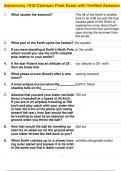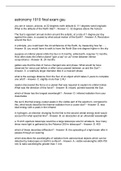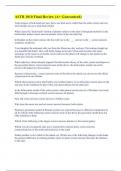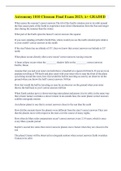Astronomy 1010 final exam - Study guides, Class notes & Summaries
Looking for the best study guides, study notes and summaries about Astronomy 1010 final exam? On this page you'll find 39 study documents about Astronomy 1010 final exam.
Page 4 out of 39 results
Sort by

-
Astronomy 1010 Clemson Final Exam with Verified Answers
- Exam (elaborations) • 11 pages • 2024
-
- $10.09
- + learn more
Astronomy 1010 Clemson Final Exam with Verified Answers 1. What causes the seasons? The tilt of the Earth's rotation axis to its orbit around the Sun causes parts of the Earth to experience more direct illumi- nation from the Sun and longer days during the summer than the winter. 2. What part of the Earth spins the fastest? the equator 3. If you were standing at Earth's North Pole, at the zeni

-
Astronomy 1010 Clemson Final Exam with Complete & Verified Solutions
- Exam (elaborations) • 14 pages • 2023
-
- $10.49
- + learn more
What causes the seasons? - ANSWER The tilt of the Earth's rotation axis to its orbit around the Sun causes parts of the Earth to experience more direct illumination from the Sun and longer days during the summer than the winter. What part of the Earth spins the fastest? - ANSWER the equator If you were standing at Earth's North Pole, where would you see the north celestial pole relative to your zenith? - ANSWER at the zenith If the star Polaris has an altitude of 35°, then we know that ...

-
Astronomy 1010 Clemson Final Exam with Complete & Verified Solutions
- Exam (elaborations) • 14 pages • 2023
-
- $11.48
- + learn more
What causes the seasons? - ANSWER The tilt of the Earth's rotation axis to its orbit around the Sun causes parts of the Earth to experience more direct illumination from the Sun and longer days during the summer than the winter. What part of the Earth spins the fastest? - ANSWER the equator If you were standing at Earth's North Pole, where would you see the north celestial pole relative to your zenith? - ANSWER at the zenith If the star Polaris has an altitude of 35°, then we know that ...
Astronomy 1010 Final Exam GSU with 100% correct solutions ASTR 1010 Final Vanderbilt; 100% VERIFIED (GRADED A+) Astronomy 1010 Clemson Final Exam 2023; A+ GRADED

-
Astronomy 1010 Clemson Final Exam with Complete & Verified Solutions
- Exam (elaborations) • 14 pages • 2023
-
- $11.49
- + learn more
Astronomy 1010 Clemson Final Exam with Complete & Verified Solutions What causes the seasons? - ANSWER The tilt of the Earth's rotation axis to its orbit around the Sun causes parts of the Earth to experience more direct illumination from the Sun and longer days during the summer than the winter. What part of the Earth spins the fastest? - ANSWER the equator If you were standing at Earth's North Pole, where would you see the north celestial pole relative to your zenith? - ANSWER at the ...

-
Astronomy 1010 Clemson Final Exam with Complete & Verified Solutions
- Exam (elaborations) • 14 pages • 2024
-
- $14.49
- + learn more
What causes the seasons? - ANSWER The tilt of the Earth's rotation axis to its orbit around the Sun causes parts of the Earth to experience more direct illumination from the Sun and longer days during the summer than the winter. What part of the Earth spins the fastest? - ANSWER the equator If you were standing at Earth's North Pole, where would you see the north celestial pole relative to your zenith? - ANSWER at the zenith If the star Polaris has an altitude of 35°, then we know th...

-
Stars and Galaxies 9th Edition by Seeds - Test Bank
- Exam (elaborations) • 479 pages • 2023
-
- $24.59
- + learn more
Chapter_03_Moon_Phases_and_Eclipses 1 The Moon moves slowly against the background of the constellations. True False 2 Any location on the Moon is sunlit for three weeks and is in darkness for one week as the Moon rotates. True False 3 In most months, there are no eclipses. True False 4 As the illuminated part of the Moon grows larger from new to full, it is said to "wane". True False 5 Our calendar divides the year into 30day periods in recognition...

-
astronomy 1010 final exam gsu
- Exam (elaborations) • 3 pages • 2023
-
- $10.39
- + learn more
you are in tuscon, arizona, at 32 degrees north latitude & 111 degrees west longitude. What is the altitude of the North Star? - Answer- C. 32 degrees above the horizon The Sun's apparent annual motion around the ecliptic, at a rate of 1 degree per day against the stars, is caused by what actual motion of the Earth? - Answer- A. Revolution around the Sun in principle, you could learn the circumference of the Earth, by measuring how far... - Answer- B. you would have to walk to have the No...

-
Astronomy 1010
- Package deal • 17 items • 2023
-
- $73.71
- + learn more
Astronomy 1010 Exam 1 (A+ Guaranteed) ASTR 1010 Final Review (A+ Guaranteed) Astronomy 1010 Final Exam (A+ Graded already) ASTR 1010 Exam 1 (100% correct answers) ASTR 1010 (all correctly answered) Astronomy 1010 Midterm (100% correct answers) ASTR 1010 Test 1 (with accurate answers 100%) Astronomy 1010 - Chapter #5 (100% correct solutions) ASTR 10

Do you wonder why so many students wear nice clothes, have money to spare and enjoy tons of free time? Well, they sell on Stuvia! Imagine your study notes being downloaded a dozen times for $15 each. Every. Single. Day. Discover all about earning on Stuvia



